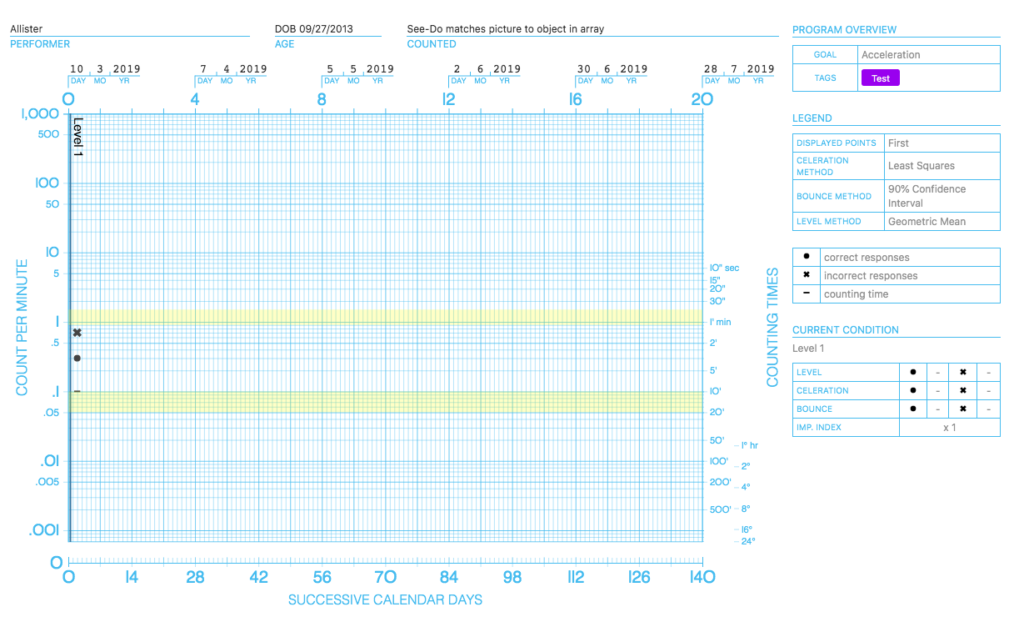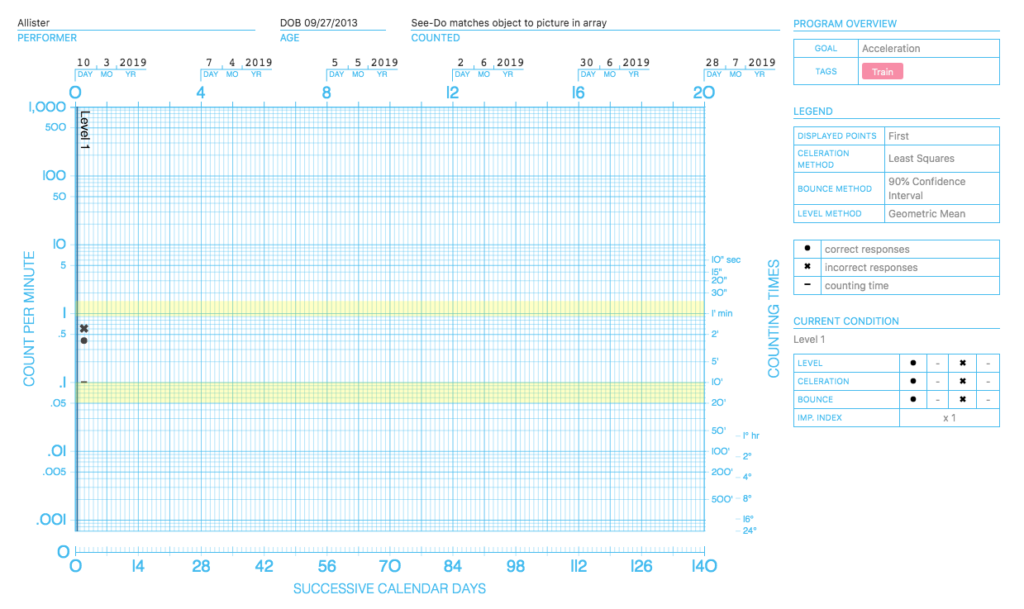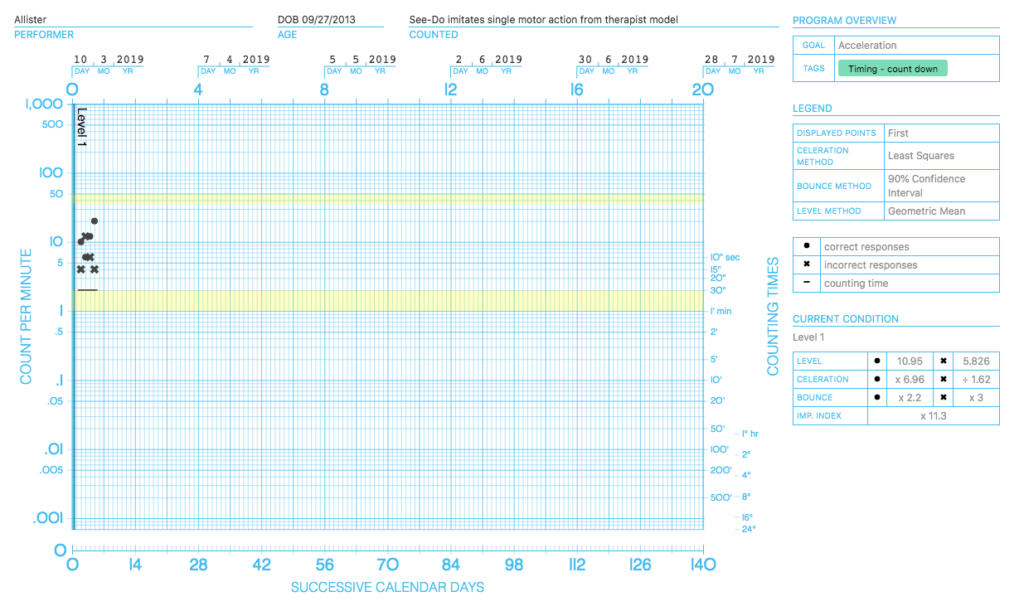By Amy Evans, M.Ed, BCBA
CentralReach Sr. Clinical Strategist
Promoting the Emergence of Advanced Knowledge (PEAK) curriculum offers a unique approach to constructing learning-to-learn repertoires that support the emergence of skills that have not been directly taught. When implementing PEAK effectively, practitioners can expect to accelerate superior outcomes for clients.
From a measurement perspective, PEAK is special in that each of its programs tie directly to a measurable outcome. For any given program, regardless of the specific targets you choose to introduce and “train,” the bigger picture is clear – to see development on the “test” skill.
This makes it easy to prioritize what to measure.
You can start with the dependent variable, or the “test”. Your progress monitoring system should serve the primary function of helping you determine whether your daily intervention (teaching and shaping across multiple exemplars in the “train” condition) is producing the intended outcome of symmetry, reflexivity, transitivity, or generalization.
For the secondary purpose of making minor adjustment to stimuli or teaching procedures, you can also collect micro-level data on performance in your daily intervention, or the “train” condition. These data empower implementers with immediate information about their own effectiveness with certain prompting procedures, error correction techniques, and other environmental arrangements they may have modified during a session. For decision makers, viewing these data on the Standard Celeration Chart every few days not only helps guide programming changes, but may also illuminate patterns in responding related to variables like day of the week, long breaks between sessions, or staff person working with the learner.
Practitioners using the PEAK curriculum can easily meet their measurement needs and much more within the Precision Teaching system. First, pinpointing behaviors can improve the countability of the targets taught and measured (Smith et al 2013). For more on using pinpoints for PEAK, check out CentralReach Director of Research Dr. Rick Kubina’s blog on this very topic. Second, recording behavior using the most useful dimensional measure — frequency (count per time) — can enhance the information gleaned in the measurement process.
Here’s how those data might look on a Standard Celeration Chart.


In this example, you can view a rewritten equivalence program using pinpointing language on two Daily per Minute Standard Celeration Charts. The “test” pinpoint (above) is “see-do matches picture to object in array,” and the “train” pinpoint (below) is “see-do matches object to picture in array.” In each of these charts, “Level 1” is the slice labeled on the chart. Within this slice is a list of the stimuli used: ball, book, pencil, block, bear, cup, feather, and quarter.
For each of these pinpoints, a 10-minute counting time is used, and trials are conducted as written within a 10-minute time period. This is an arbitrary counting time, so it can be shortened if your trial blocks tend to take less time. Aim bands are set to indicate a goal of 10-15 correct, independent responses and 0-1 incorrect responses per 10 minutes. This aim is designed to capture accuracy and independence.

Once these data land on the Standard Celeration Chart, the next steps in the Precision Teaching process include analyzing the charted data and making changes if necessary. Finally, try again if those changes didn’t provide the intended outcomes. Using Precision Teaching with PEAK really can be that simple!
But if you want to accelerate learning even more efficiently, then consider adding frequency building to your implementation of PEAK. Although mastery criteria in PEAK are not currently written with fluency in mind, many can be easily modified for an additional frequency building phase between acquisition and mastery. Certain programs are obvious candidates for this approach, as they lend themselves to free-operant responding, benefit from increased pace, and foster fluency with targeted skills that facilitate additional skill acquisition throughout the curriculum.
One of these obvious candidates for a focus on fluency is motor imitation. Here’s an example of a chart set up for frequency building, using the pinpoint: “see-do imitates single motor action from therapist model.”


In this example, the aim band is set to 17-25 correct imitative responses per 30 seconds (35-50 per min), and 0-1 incorrect responses per 30 seconds. Reaching this frequency aim has resulted in outcomes like retention, endurance, stability, and application for learners with autism (Fabrizio & Moors, 2003). Once the aim is reached, your next step as a clinician is to test for these outcomes indicative of fluency.
If you implement PEAK in your clinical practice, consider a few additions to enhance the process: consider (1) pinpointing the target behaviors for the purpose of clarity, (2) using rate of response to learn more about performance, (3) graphing data and making decisions using the Standard Celeration Chart, and (4) sprinkling in frequency building to accelerate generative outcomes.
About the Author

Amy Evans, M.Ed., BCBA
CentralReach Sr. Clinical Strategist
Amy L. Evans, M.Ed., BCBA is Senior Clinical Strategist at CentralReach LLC. Amy has been a practitioner of Precision Teaching and Applied Behavior Analysis since 2008, and a Board Certified Behavior Analyst since 2014. Amy earned her undergraduate degree from the University of Nevada, Reno and a Masters in Special Education from the Pennsylvania State University. Amy has worked in private learning centers, public school classrooms, home-based intervention and homeschool settings, combining the principles of Behavior Analysis, Precision Measurement, and Direct Instruction to solve educational and behavioral challenges for learners from 4 to 18 years old, with and without learning or developmental disabilities. Amy’s current work at CentralReach includes designing and implementing training programs for autism providers who are looking to accelerate behavior change and learning outcomes with precise measurement, fluency-based instruction, and data-based decision making.



